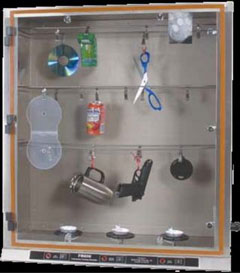Cyanoacrylate Fuming — A Mainstay of Crime Scene Investigation
Don Penven
Developing Latent Prints With Superglue
In the late 1970s, members of the US Army CID Lab in Japan brought home a novel method for developing latent prints. The forensic scientists in the Tokyo National Crime Lab had discovered that the fumes from cyanoacrylate adhesives (CA) or superglue, reacted with the moisture of latent fingerprints in such a way that a latent print on a non-porous surface was covered with a hard coating that encased the delicate ridge structure of the latent print.
Today, at least here in the U.S., superglue fuming is a basic step in the crime-solving playbook for a majority of crime labs. Back in the early days of superglue research, fuming chambers ranged from large plastic bags to converted fish tanks. Many new, more functional appliances are now available.

The pros and cons of employing superglue fuming are many: On the PRO side—it protects fragile latent prints by resisting accidental bumps and scuffs that would damage the ridges, it encapsulates the moisture content of a latent thus preventing vaporization and it is a means of processing large quantities of evidence at one time in all shapes and sizes.
On the CON side; superglue fuming produces white latent prints that often require the addition of a contrasting color to enable better viewing and photography of the latents, and it leaves a white residue on many of the surfaces the fumes contact. Although some early literature indicated that the fumes may be toxic, this theory has been disproven. The fumes are noxious but not dangerous.
Over the years many innovative advances have grown out of basic research employing superglue. Among some of the best ideas is vacuum fuming. Researchers discovered that superglue is a top performer when evidence and a few drops of superglue are sealed into a vacuum chamber. Current Lab-Type Fuming Cabinet users of the vacuum fuming method report that is possible to fill a chamber with numerous articles, including evidence such as large plastic trash bags, and cramming in all that will fit seems to have little or no effect on getting excellent results.
During the first few years of superglue experimentation, researchers sought a means of accelerating the development. Faster is better—right? Not necessarily. One of the first acceleration methods was impregnating cotton pads with a sodium hydroxide solution. This did indeed produces near instant clouds of white smoke. But over time such use fell into disfavor due to health-related concerns.
Two of today's most popular methods for superglue acceleration are:
- Apply superglue to untreated cotton pads. This is quite safe and provides much faster fuming than just placing a few drops of glue inside a fuming chamber.
- The application of heat is quite effective in speeding up the development process. This is accomplished by using a small coffee warmer. More sophisticated fuming chambers have built-in heaters.
A number of crime labs are encouraging crime scene investigators to fume fragile evidence prior to packaging for transmittal to the crime lab. This step has probably saved countless numbers of latent prints from being accidently destroyed during shipment to the crime lab.
Cyanoacrylate fuming is the number one choice as a first step in locating latent prints on non-porous surfaces. Until something better comes along, the crime scene technician should consider adding this process to the crime scene equipment kit — if this hasn't been done already.
About the Author

Don Penven has more than 35 years direct and indirect experience in law enforcement. He currently serves as a technical support representative and technical writer for Sirchie Finger Print Labs.
Article submitted by the Author
Article posted: February 27, 2015

